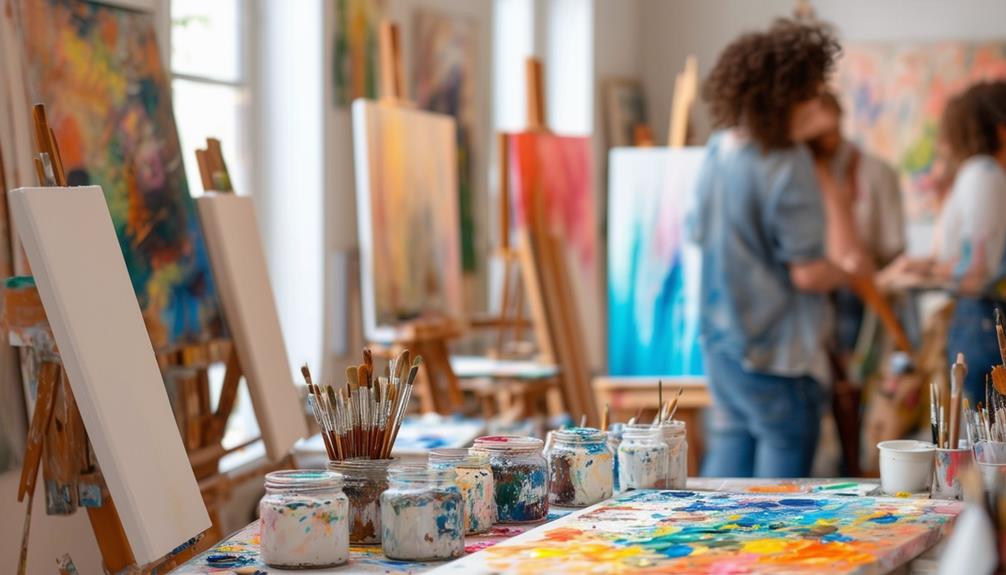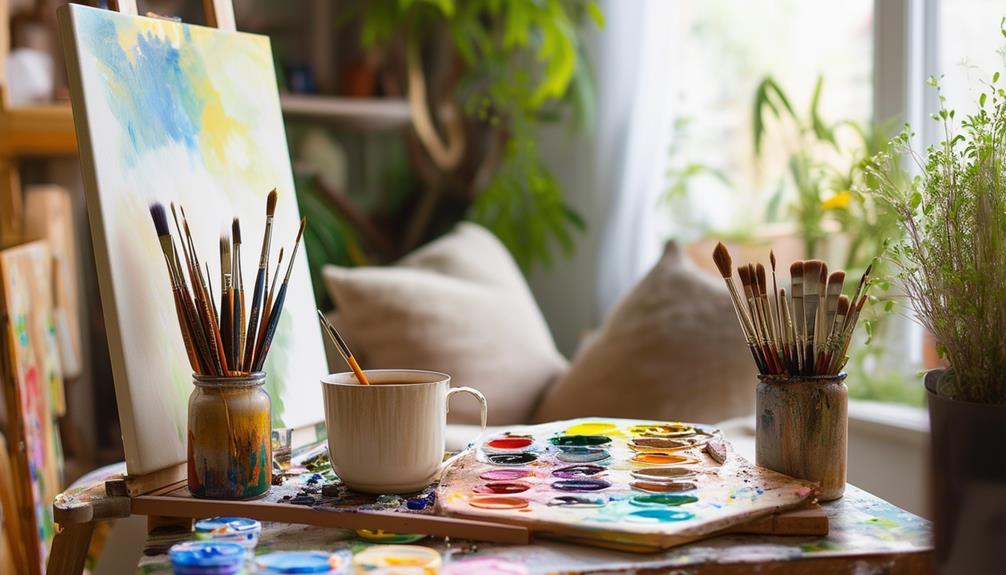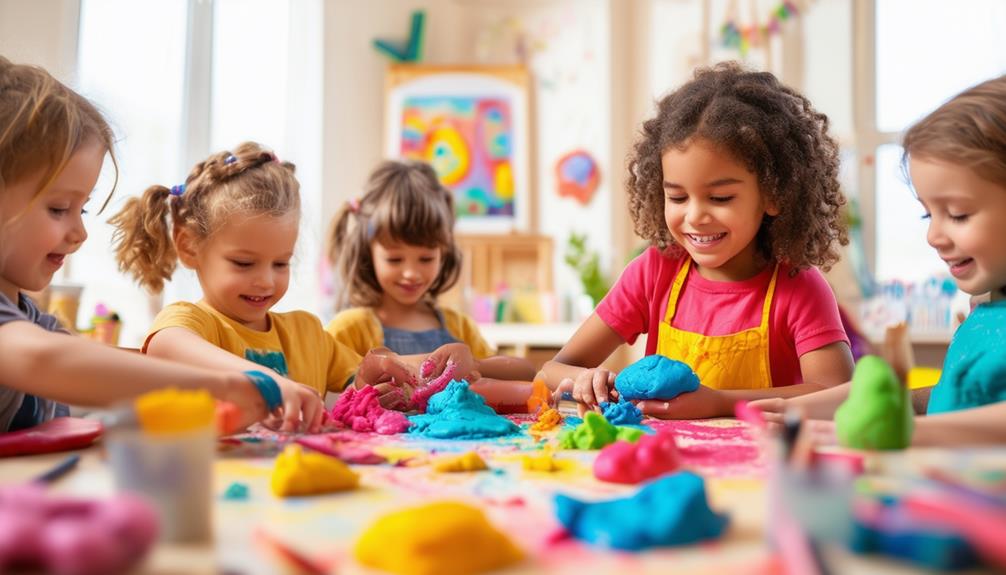How to Encourage Reluctant Painters to Get Creative

Encouraging reluctant painters to embrace creativity begins with addressing their initial fears and hesitations. It's crucial to create a supportive environment where they feel safe to experiment and make mistakes. Offering a variety of materials can ignite curiosity and provide different ways to express themselves. Positive reinforcement is vital, as it helps build confidence and a willingness to try new things. By breaking down the creative process into manageable steps and emphasizing the value of learning from mistakes, you can transform reluctance into enthusiasm. Let's explore practical strategies to achieve this transformation.
Coping With Creative Blocks
Overcoming creative blocks is a common challenge for painters, but with the right support and strategies, it can be managed effectively. One powerful approach is to engage with a community of like-minded individuals. Sharing your creative process with others can spark new ideas and provide valuable feedback, making the journey less isolating and more collaborative.
Recognize that struggling is a natural part of artistic growth. Connecting with mentors who openly discuss their own challenges can normalize the experience of creative blocks. This transparency offers reassurance and practical guidance, helping you navigate your own periods of stagnation.
Seeking inspiration from diverse sources can also rekindle your passion for painting. Reflect on your inner thoughts, observe your surroundings, or explore other creative works to find your spark. Sometimes, a change of scenery or perspective is all you need to get the creative juices flowing again.
Effective Creation Strategies
You can make painting less intimidating by breaking projects into smaller, manageable tasks. Frequent short painting sessions can help maintain your motivation and keep your creativity flowing. These strategies ensure that you'll enjoy the process without feeling overwhelmed.
Frequent Short Painting Sessions
How can frequent brief painting sessions transform a hesitant painter's approach to creativity? Frequent brief painting sessions are an excellent way to motivate hesitant painters who might feel overwhelmed by longer, more demanding projects. By dedicating just a small amount of time regularly, the process becomes less daunting and more welcoming. This method helps build confidence and fosters a sense of achievement, which is crucial for unlocking creative potential.
Here's how brief painting sessions can make a difference:
- Encourage Regular Practice: Consistency is key. Short sessions make it easier to incorporate painting into a regular routine.
- Reduce Pressure: A short time commitment can lower the stakes, making creative exploration more approachable.
- Build Confidence: Achieving small, frequent successes can gradually build a painter's confidence.
- Maintain Interest: Brief sessions keep the activity fresh and exciting, preventing burnout.
Break Projects Into Chunks
Why not break your painting projects into manageable portions to make the process less overwhelming and more motivating? For hesitant painters, this strategy can transform a challenging task into a series of achievable steps. Start by dividing your painting into smaller tasks: sketching, blocking in colors, and adding details. Each step focuses on a specific aspect, helping to reduce stress and allowing you to concentrate on one section at a time.
By breaking your painting projects into portions, you'll find the process less intimidating and more doable. Tackling smaller tasks not only increases motivation but also builds a sense of accomplishment. As you complete each stage, you'll gradually refine your skills and gain confidence in your abilities.
Moreover, this approach can help you overcome perfectionism and the fear of failure. When you focus on smaller parts of the project, the pressure to produce a perfect painting diminishes. This makes the experience more enjoyable and encourages you to experiment and take creative risks.
Reflection and Inspiration

Reflect on what initially drew you to painting and let those memories spark new ideas. Surround yourself with art that resonates with you and observe the beauty in your environment for fresh inspiration. By reconnecting with your artistic motivations, you'll find the drive to create again.
Discover Surrounding Beauty
Reigniting your creativity often begins with pausing to observe and appreciate the beauty around you. Take a moment to truly see the world with fresh eyes and find inspiration in the details you might have overlooked. The wisdom in your surroundings can offer a wellspring of artistic ideas, waiting to be tapped into.
Consider these simple yet powerful actions to help you explore the beauty that surrounds you:
- Take a nature walk: Notice the colors, textures, and patterns in the leaves, flowers, and sky.
- Visit a local art gallery: See how other artists capture and interpret the world around them.
- Listen to music: Let the melodies and rhythms evoke emotions and images in your mind.
- Journal your thoughts: Write down what you observe and appreciate; this can later translate into visual art.
Reflect Artistic Motivations
Exploring your artistic motivations can reveal deep-seated passions and rekindle your drive to create. Reflect on why you first picked up a paintbrush. Was it to express emotions beyond words or to delve into your creativity? Painting serves as a powerful medium for self-expression, enabling you to convey your inner world without speaking.
Consider what inspires you. Is it the beauty of nature, the intensity of your emotions, or the vividness of your memories? These elements can provide a rich tapestry for your art. Reflecting on these motivations can reconnect you with the joy and fulfillment of creating something unique and meaningful.
Don't underestimate the power of reflection. It can help you overcome reluctance. Understanding why you want to paint makes it easier to push past hesitation. Whether it's capturing the serenity of a landscape or the complexity of human emotions, your motivations can drive you to explore new dimensions of creativity. So, take a moment to reflect and let these inspirations guide your brush.
Seek Internal Inspiration
Tapping into internal motivation can unlock a wealth of creativity. To fully unleash your potential, reflect on your artistic motivations and interests. By seeking inspiration from within, you can create art that is deeply personal and unique. Here are some ways to fuel that internal spark:
- Explore Your Emotions: Use your feelings as a source for art ideas. Joy, sorrow, anger, and love can all translate into impactful visual expressions.
- Reflect on Personal Experiences: Your life story is a goldmine of inspiration. Immerse yourself in memories and significant moments to find creative cues.
- Observe Your Surroundings: Sometimes, the most ordinary aspects of daily life can offer unexpected artistic insights.
- Adopt a Growth Mindset: Embrace challenges and see them as opportunities for growth. This mindset can lead to fresh and exciting paths in your art.
Encouragement is crucial. Remind yourself that creating art is an exploration of self-discovery. Allow your unique perspectives to shine, and don't hesitate to experiment. By connecting with your inner artist, you'll reignite your passion for painting and uncover endless possibilities.
Artistic Exploration and Growth
Exploring various mediums and techniques can help hesitant painters discover what truly resonates with them. Encouraging experimentation with different mediums like watercolor, acrylics, oils, or digital painting can ignite interest and creativity. Each medium's unique qualities can offer new perspectives and inspire artistic growth.
Attending workshops or classes together can be a powerful confidence booster. These settings provide structured learning and a supportive environment where mistakes are seen as learning opportunities. This safe space is essential for building confidence and allows hesitant painters to take creative risks without fear of judgment.
Collaboration is another valuable strategy. Encourage them to work with other artists or peers. The exchange of ideas can be incredibly inspiring and often leads to creative breakthroughs. Being part of a supportive artistic community fosters encouragement and motivation, making experimentation more appealing and less intimidating.
Self-Care and Balance

Prioritizing self-care is essential for sustaining your creativity and preventing burnout in your painting journey. Taking care of yourself helps maintain balance and keeps your creative energy flowing. Sometimes, stepping away from the canvas is just as important as engaging with it. Here are some tips to help you achieve that balance:
- Engage in other hobbies: Activities outside of painting can rejuvenate your mind and body.
- Practice mindfulness: Simple mindfulness exercises can enhance your presence and focus during painting sessions.
- Listen to your body: Pay attention to signals indicating it's time for rest and relaxation.
- Incorporate relaxation techniques: Methods like deep breathing or meditation can help you unwind and recharge.
Balancing painting with other aspects of life is crucial for overall well-being. Engaging in different hobbies can bring fresh perspectives to your art. Mindfulness helps you stay present, making each brushstroke more intentional. Relaxation techniques can reduce stress, enhancing your creativity.
Creating a Supportive Environment
Cultivate a welcoming and supportive atmosphere where each painter's unique artistic expression is celebrated. Begin by providing positive reinforcement and constructive feedback to enhance confidence and motivate hesitant painters to develop their skills. Offer a variety of art materials and tools to spark interest and creativity, ensuring students feel more engaged and enthusiastic about their work.
Creating a nurturing environment involves viewing mistakes as learning opportunities. Encourage artists to see errors not as setbacks but as steps toward growth, promoting a growth mindset essential for experimentation with new techniques. Remind them that every great artist started with trial and error.
Peer encouragement is also crucial. Foster collaboration and support among peers to help hesitant artists feel more at ease. Seeing others try new things and offer support can inspire them to discover their own creativity.




